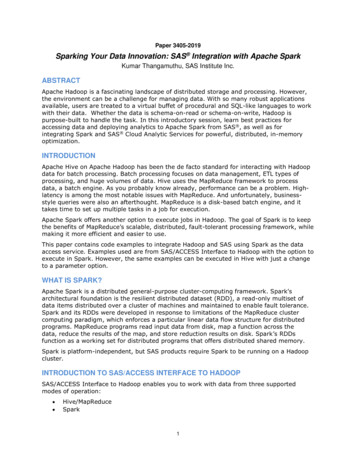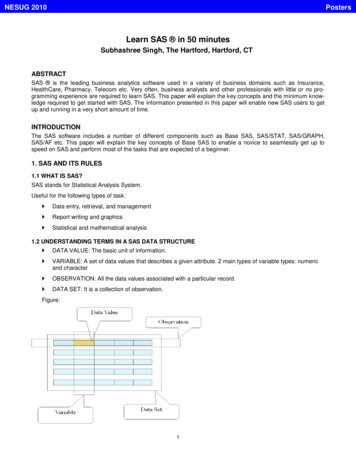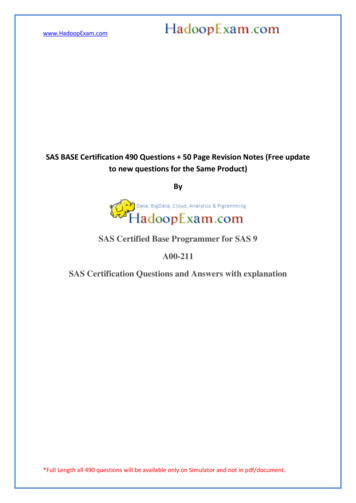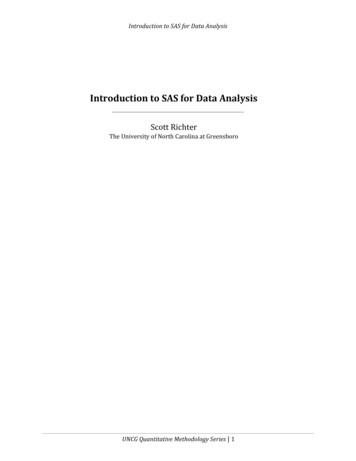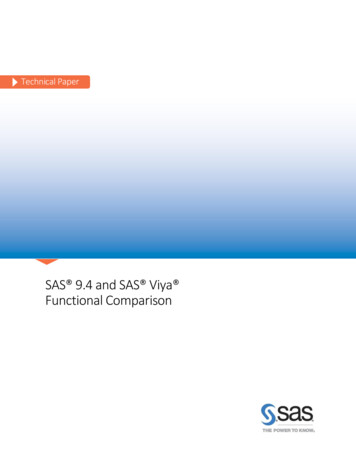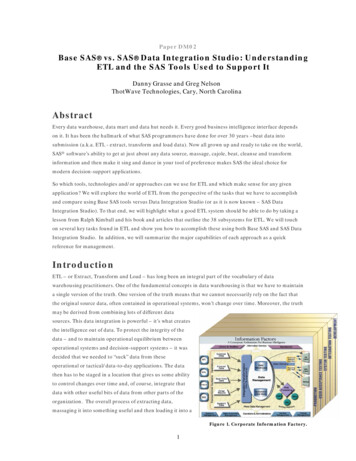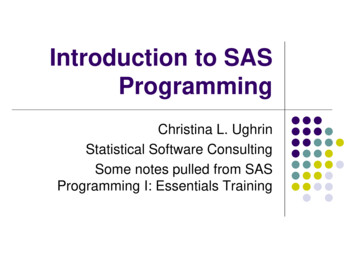
Transcription
Introduction to SASProgrammingChristina L. UghrinStatistical Software ConsultingSome notes pulled from SASProgramming I: Essentials Training
SAS DatasetsExamining the structure of SASDatasets
SAS Data SetsTwo SectionsDescriptor SectionData Section
Data Set Descriptor Section
SAS Data Section
Attributes of Variables Name e.g. StatusType Numeric or Charactere.g. Status in this example is character (T, TT,PT, or NTT) and Satisfaction is numeric (1 to 5).
SAS Data Set Terminology Variables – columns in a SAS data set.Observations – rows in a SAS data set.Numeric Data – values that are treated as numericand may include 8 bytes of floating storage for 16 to17 significant digits.Character Data – non numeric data values such asletters, numbers, special characters, and blanks.May be stores with a length of 1 to 32, 767 bytes.One byte is equal to one character.
SAS Data Set and VariableName Criteria Can be 32 characters long.Can be uppercase, lowercase, or a mixture ofthe cases.Are not case sensitiveCannot start with number and cannot containspecial characters or blanks.Must start with a letter or underscore.
SAS Dates Dates are treated as special kind of numeric data. They are the number of days since January 1st, 1960.January 1st 1960 is the 0 point. SAS dates can go back to1582 (Gregorian Calendar) and forward to the year 20000.Dates are displayed using a format. There are a number ofdifferent date formats supported by SAS.Time is scored as the number of seconds sincemidnight. SAS date time is the number of secondssince January 1st, 1960.
Missing Data in SAS Missing values are valid values. For character data, missing values are displayed as blanks.For numeric data, missing values are displayed as periods.
SAS Syntax
SAS Syntax Statements in SAS are like sentences. Thepunctuation though is a semicolon( ; )ratherthan a period ( . )Most Statements (but not all) start with anidentifying key word (e.g. proc, data, label,options, format )Statements are strung together into sectionssimilar to paragraphs. These paragraphs in aWindows OS are ended with the word “run”and a semicolon.
Example of SAS Syntax
SAS Syntax Rules SAS statements are format free.One or more blanks or special characters areused to separate words.They can begin and end in any column.A single statement can span multiple lines.Several statements can be on the same line.
Example of SAS Free FormatUsing the free-format Syntaxrules of SAS though can make it difficult for others (or you) to read yourprogram. This is akin towriting a page of text with little attention to line breaks. You may still haveCapital letters and periods, but where a sentence begins and ends may be a bit confusing.
Example of SAS FormattedUsing the free-format Syntax rules of SAS though can make it difficult for others(or you) to read your program. This is akin to writing a page of text with littleattention to line breaks. You may still have capital letters and periods, but where asentence begins and ends may be a bit confusing. Isn‟t this paragraph a biteasier to read?
SAS Comments Type /* to begin a comment.Type your comment text.Type */ to end the comment.Or, type an * at the beginning of a line. Everythingbetween the * and the ; will be commented. e.g. *infile „tutor.dat‟;Alternatively, highlight the text that you would like tocomment and use the keys Ctrl / to comment theline. To uncomment a line, highlight and use theCtrl Shift / keys.
SAS Comments
SAS Windows
SAS WindowsExplorerLogEditor
Enhanced Editor WindowOutputEnhancedEditor Your program script appears in this window.You can either bring it in from a file or type the program right into the window.Once the program is in the window, you can Click Submit (or the running guy).
SAS Log SAS Log provides a “blow by blow” account of the execution of your program. Itincludes how many observations were read and output, as well as, errors and notes.Note the errors in red.
Output Window
SAS Library SAS Data Libraries are like drawers in a filing cabinet. The SAS data sets are fileswithin those drawers. Note the icons for the SAS library match that metaphor.In order to assign a “drawer”, you assign a library reference name (libref).There are two drawers already in your library: work (temporary) and sasuser(permanent).You can also create your own libraries (drawers) using the libname statement.
Establishing the libnameType the libnamecommand in theEnhanced Editor.Click on therunning iconlibname Tina „E:\Trainings\JMP Training‟;run;
Viewtable Window
Data Step Programming SAS data set can be created using another SASdata set as input or raw dataTo create a SAS data set using another SAS dataset, the DATA and SET statements are used.To create a SAS data set from raw data, you useINFILE and INPUT statements.DATA and SET cannot be used for raw data andINFILE and INPUT cannot be used for existing SASdatasets.
Reading a SAS DatasetDATA (name of new SAS dataset)SET (name of existing SAS dataset)Additional statementsRun;
Reading a SAS Dataset
Reading SAS Dataset
Reading Raw Data
Selecting Variables You can use a DROP or KEEP statement in aDATA step to control which variables arewritten to a new SAS data set.
Selecting Variables
Selecting Variables
Date Functions Create SAS date values TODAY() – obtains the date value from the system clockMDY(month,day,year) – uses numeric month, day, andyear values to return the corresponding SAS date value.Extract information from SAS date values YEAR (SAS-date) – extracts the year from a SAS date andreturns a four-digit value for yearQTR (SAS-date) – extracts the quarter from a SAS dateand returns a number from 1-4MONTH (SAS-date) extracts the month from a SAS dateand returns a number from 1 to 12WEEKDAY (SAS-date) – extracts the day of the week andreturns a number from 1 to 7
Date Function – WeekdayFunction
Proc UnivariateProc Univariate
Proc Univariate
Proc Univariate
Getting started withprogrammingProc Print
Proc Print – BeginningProcedures Examining data using proc print procedure.Display particular variables of interest.Display particular observations.Display a list report with column totals.
Default List ReportProc print data train.sastraining;Run;
Printing Particular Variables Use the VAR statementwhich allows you to:Select variables for yourproc print Define the order of thevariables in the procprint.Proc printdata train.sastraining;var ID DepartmentSatisfaction;Run;
Suppressing Obs ColumnThe NOOBS optionsuppresses the numberof observations columnthat shows up on theleft hand side of a procprint output.Proc printdata train.sastrainingNOOBS;Run;
Subsetting Data with theWHERE Statement Allows you to select particular observations basedon criteria.Can be used with most SAS procedures (“IF”statements are generally used in the Data stepthough).Operands Variables and ObservationsOperators ComparisonsLogical,SpecialFunctions
Comparison OperatorsMneumonicSymbolDefinitionEQ equal toNE or not equal toGT greater thanLT less thanGE greater than or equal toLE less than or equal toINequal to one of a list
Examples of WHEREComparison OperatorsProc printdata train.sastrainingNOOBS;where department „Psychology‟;Run;proc print data train.sastrainingNOOBS;where department 'Psychology';run;
WHERE Logical Operators And (&) Used if both expressions are true,then the compound expression is true. OR ( ) Used if either expression is true, thenthe compound expression is true. Not ( ) Can be combined with other operatorsto reverse the logic of a comparison.
Examples of WHERE LogicalOperatorsproc print data train.sastraining NOOBS;where department 'Psychology' andyears 10;run;proc print data train.sastraining NOOBS;where department 'Psychology' ordepartment 'Anthropology';run;
WHERE Special Operators BETWEEN-AND – Used to selectobservations in which the value of thevariable falls within a range of values. CONTAINS ? – Used when one wants toselect observations that include the specifiedsubstring.
Examples of WHERE SpecialOperatorsproc print data train.sastraining NOOBS;where years between 10 and 15;run;proc print data train.sastraining NOOBS;where Department ? 'Nurs';run;
Column Totals Can provide a Total Can also provide subtotals if data is printed ingroups.
Example of Column Total
Proc Sort
Overview of Proc Sort Sorts (arranges) observations of the data set.Can create a new SAS data set containingrearranged observations.Can sort on more than one variable at a time.Sorts ascending (default) and descending.Does not provide printed output (that requiresthe proc print statements).Treats missing data as smallest possiblevalue.
Proc Sort Exampleproc sort data train.sastraining;by Department;run;proc print data train.sastraining NOOBS;var Department Satisfaction Years;run;
Printing Totals and Subtotals ProcSort and Proc Print Exampleproc sort data train.sastraining;by Department;run;proc print data train.sastraining NOOBS;by Department;sum years;run;
Page Breaks with Proc Sortand Proc Printproc sort data train.sastraining;by Department;run;proc print data train.sastraining NOOBS;by Department;Pageby Department;sum years;run;
SAS Comments Type /* to begin a comment. Type your comment text. Type */ to end the comment. Or, type an * at the beginning of a line.Everything between the * and the ; will be commented. e.g. *infile „tutor.dat‟; Alternatively, highlight the text that you would like to comment and use the keys Ctrl / to com

